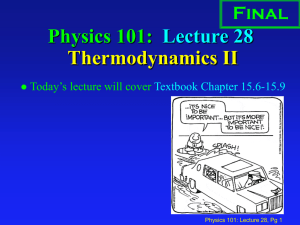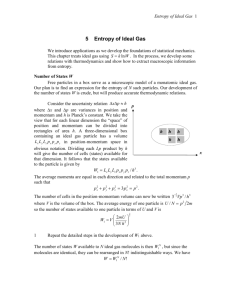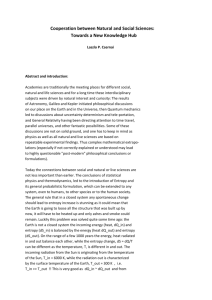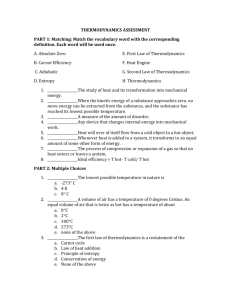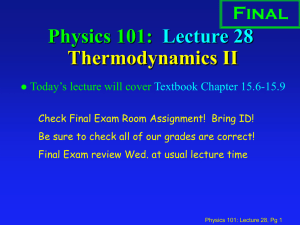Tipler Chapter 19 Name: #1 Work & Efficiency from a PV
advertisement
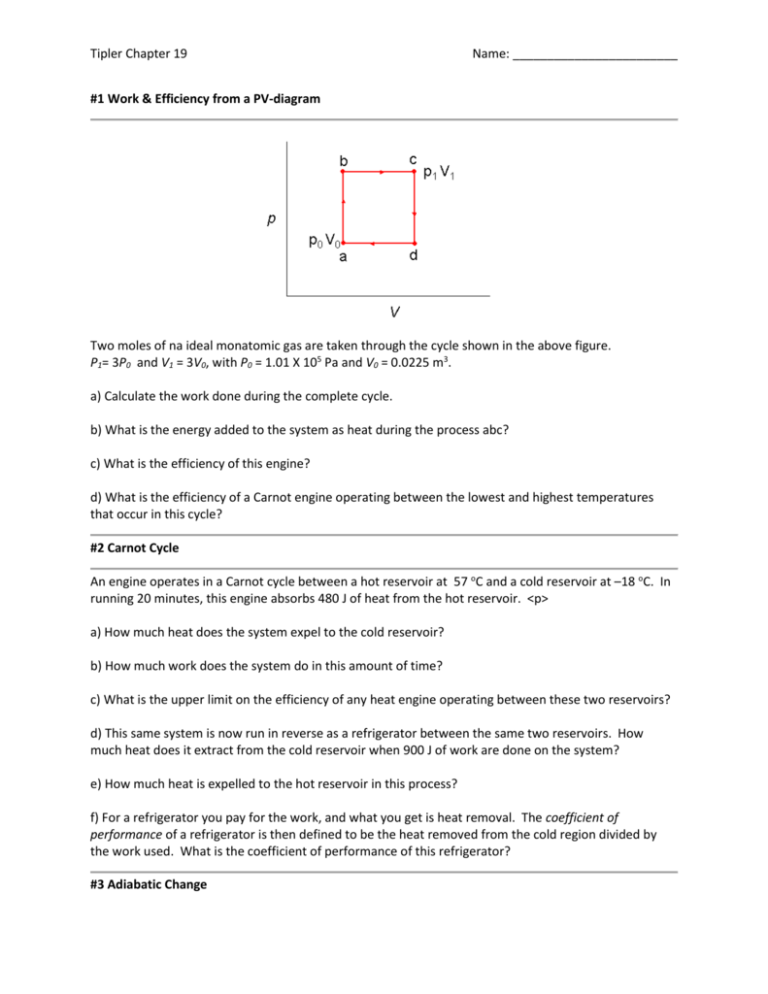
Tipler Chapter 19 Name: ________________________ #1 Work & Efficiency from a PV-diagram Two moles of na ideal monatomic gas are taken through the cycle shown in the above figure. P1= 3P0 and V1 = 3V0, with P0 = 1.01 X 105 Pa and V0 = 0.0225 m3. a) Calculate the work done during the complete cycle. b) What is the energy added to the system as heat during the process abc? c) What is the efficiency of this engine? d) What is the efficiency of a Carnot engine operating between the lowest and highest temperatures that occur in this cycle? #2 Carnot Cycle An engine operates in a Carnot cycle between a hot reservoir at 57 oC and a cold reservoir at –18 oC. In running 20 minutes, this engine absorbs 480 J of heat from the hot reservoir. <p> a) How much heat does the system expel to the cold reservoir? b) How much work does the system do in this amount of time? c) What is the upper limit on the efficiency of any heat engine operating between these two reservoirs? d) This same system is now run in reverse as a refrigerator between the same two reservoirs. How much heat does it extract from the cold reservoir when 900 J of work are done on the system? e) How much heat is expelled to the hot reservoir in this process? f) For a refrigerator you pay for the work, and what you get is heat removal. The coefficient of performance of a refrigerator is then defined to be the heat removed from the cold region divided by the work used. What is the coefficient of performance of this refrigerator? #3 Adiabatic Change Argon gas, initially at pressure 100 kPa and temperature 300 K, is allowed to expand adiabatically from 0.0100 m3 to 0.0320 m3 while doing work on a piston. In this problem you will calculate the contributions to the entropy change. a) What is the change in entropy due to the volume change alone, ignoring any effects of changing internal energy? b) If the expansion is adiabatic, what is the final temperature? c) What is the change in entropy solely due to the change of temperature, ignoring the entropy change due to the volume change? d) What is the total change of the entropy in this adiabatic expansion? e) How much work was done on the piston? #4 Variable Heat Capacity Most materials (e.g. metals, glasses, etc.) have heat capacities that depend on temperature. Let's say that we're considering a block of metal whose heat capacity C(T) is linearly proportional to T, and has the value 25 J/K at T= 10 K.<p> a) At T = 40 K, what is the heat capacity? b) How much heat is needed to raise the temperature of the block from 10 K to 40 K? c) By how much does its entropy increase when the temperature is increased from 10 K to 40 K? #5 Energy & Entropy from a PV-diagram An ideal monatomic gas is taken through the above cycle where P1 = 3.2 X 105 Pa and V1 = 4.8 cm3. During the cycle both the pressure and volume will change such that P2 = 2.6P1 and V2 = 4.5V1. a) How much work is done by the gas in going from state a to state c along path abc? b) What is the change in internal energy in going from b to c? c) What is the change in internal energy during the complete cycle? d) What is the change in entropy per mole of gas in going from b to c? e) What is the change in entropy per mole during the complete cycle? #6 Entropy & Melted Ice A 8.0 gm cube of ice in thrown into a bath of water containing 100 cm3 of water. The water is initially at 25 oC and the ice is –12 oC. The entire system is thermally isolated and comes to thermal equilibrium. (Note: In this problem, you may take 0 oC to be 273 K.) a) Should the change in entropy of the isolated water-ice system negative, zero, or positive as it comes to thermal equilibrium? b) What is the final temperature of the system c) What is the change in entropy of the water bath as it comes to this final temperature? (Hint: Consider the water bath alone, do not consider the ice cube at this point.) d) What is the change in entropy of the ice as it goes from –12 oC to 0 oC? e) What is the change in entropy of the ice as it melts? f) What is the change in entropy of the ice (actually melted into water) as it goes from 0 oC to its final temperature. g) What is the TOTAL change in entropy of the isolated SYSTEM as it comes to its final temperature? h) One last check: was your final value for the change in entropy of the entire system negative, zero, or positive?



